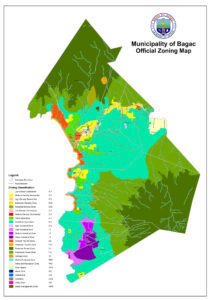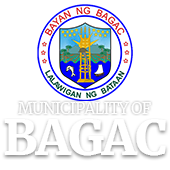Comprehensive Land Use Plan
 Bagac was founded in the year 1578 by the Franciscan Fathers. Before Bataan was
Bagac was founded in the year 1578 by the Franciscan Fathers. Before Bataan was
created as a province in 1754, Bagac used to be a part of Corrigemento de Mariveles.
The name of Bagac was derived during the arrival of Spaniards in the Philippines. Some
of them travelled along the seacoasts and happened to pass by this place that is partly
hidden between two sharp points extending to the sea. The Spaniards asked the Aeta,
who was travelling with them as their guide, for the name of that place. The Aeta
answered that is called “lumbak” meaning lying between two hills. As their ship was
crossing this place they sighted a flock of herons flying above them. When the Spaniards
inquired about them to their guide, the Aeta replied, “Iyon po ay mga ibong tagak.” And
so from “lumbak” and “tagak” came “bak” and “gak”, and soon it became Bagac.
During the Filipino-Spanish war, the natives of Bagac did their part to overthrow the
Spanish Rule in this part of Bataan. Jose Noriega, the leader of the local insurrectos led
his townmates in their fight for freedom. Among them were Juan Bantay, Ildefonso
Lucas Gonzales, Juan Quiroz, Leoncio Marquez, Atanacio Paguio, Andres Mandocdoc,
Sotero Palad, Epifanio Noriega and Pablo Dilig, to mention a few. These brave men
killed the Spanish authorities stationed in the town and offered their lives so that the
next generations to follow may be free from foreign bondage.
In the ensuing Filipino-American war, General Mascardo, together with his men,
evaded the pursuing American troops and found their way to Bagac by crossing the
wilderness of the mountain range to the western part of Bataan peninsula. In Bagac,
General Mascardo, and his men, one of whom was the late Manuel L. Quezon, camped
at Sitio Caragman. Manuel L. Quezon, then a major, met a Bagac lass whom he married
under Katipunan rites in 1900 in the yard of Mrs. Florentina Banzon Gutierrez, a rich
and influential woman of Bagac, who acted as sponsor.
Bagac played an important role in the defense of Bataan during the World War II. The
Bagac-Pilar defense line stretching about twenty-five kilometers was never broken,
much less penetrated by the Japanese. The army of Bagac stood its ground despite
tremendous odds and the defense line remained intact until the white flag was raised
signaling the fall of Bataan.
Upon the surrender of Bataan, Bagac has become one of the starting points in the
march of the USAFFE towards Capas, Tarlac. The other one was Mariveles. The soldiers
who were hoarded to a concentration camp in Capaz walked the whole distance and along the way, they were stripped and beaten like animals by the invaders. At the very
spot where the infamous “Death March” started now stands a marker and a zero
kilometer point post.
The history of Bagac also contributes to growth environment. Bagac was last stand of
the Allied Forces in Philippines against the Japanese during the Second World War. It
was between the two points from where the Zero Kilometer Death March of the
prisoners was started after they lost to Japan in the Battle of Bataan. The Japanese
friendship tower symbolizes the peace and friendship between Japan and the
Philippines. The Shrine of Valor in Mount Samat, only at a distance of 5 kilometers, is
a place of tremendous importance, commemorating as it does, the heroic deeds of the
soldiers who fought for their country, and delayed the march of the Japanese, a factor
that led to their eventual defeat in the war.

